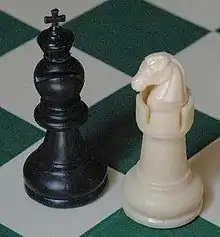Capablanca chess
Capablanca chess (or Capablanca's chess) is a chess variant invented in the 1920s by former World Chess Champion José Raúl Capablanca. It incorporates two new pieces and is played on a 10×8 board. Capablanca believed that chess would be played out in a few decades (meaning games between grandmasters would always end in draws). This threat of "draw death" for chess was his main motivation for creating a more complex version of the game.
 The archbishop combines powers of a bishop and a knight.
The archbishop combines powers of a bishop and a knight. The chancellor combines powers of a rook and a knight.
The chancellor combines powers of a rook and a knight.
| a | b | c | d | e | f | g | h | i | j | |||
| 8 | 8 | |||||||||||
| 7 | 7 | |||||||||||
| 6 | 6 | |||||||||||
| 5 | 5 | |||||||||||
| 4 | 4 | |||||||||||
| 3 | 3 | |||||||||||
| 2 | 2 | |||||||||||
| 1 | 1 | |||||||||||
| a | b | c | d | e | f | g | h | i | j |
The new pieces allow new strategies and possibilities that change the game. For example, the archbishop by itself can checkmate a lone king in the corner (when placed diagonally with one square in-between).
Setup and rules

Capablanca proposed two opening setups for Capablanca chess. His final revision placed the archbishop between the queen's knight and queen's bishop; the chancellor between the king's knight and king's bishop.[1][2] The king moves three squares when castling instead of moving two squares as in standard chess. A pawn can promote to archbishop or chancellor in addition to the regular promotion options in standard chess.[2]
Capablanca also experimented with a 10×10 board size with a different initial setup and where pawns could advance up to three squares on their first move. Edward Lasker wrote:[3]
... I played many test games with Capablanca, and they rarely lasted more than twenty or twenty-five moves. We tried boards of 10×10 squares and 10×8 squares, and we concluded that the latter was preferable because hand-to-hand fights start earlier on it.
Lasker was one of the few supporters. Hungarian grandmaster Géza Maróczy also played some games with Capablanca (who got the better of him). British champion William Winter thought that there were too many strong pieces, making the minor pieces less relevant.
The new piece names archbishop (originally named chancellor) and chancellor (originally named marshall, followed by marshal) were introduced by Capablanca himself.[4] These names are still used in most modern variants of Capablanca Chess.
Variants of Capablanca chess
Predating Capablanca chess
| a | b | c | d | e | f | g | h | i | j | |||
| 8 | 8 | |||||||||||
| 7 | 7 | |||||||||||
| 6 | 6 | |||||||||||
| 5 | 5 | |||||||||||
| 4 | 4 | |||||||||||
| 3 | 3 | |||||||||||
| 2 | 2 | |||||||||||
| 1 | 1 | |||||||||||
| a | b | c | d | e | f | g | h | i | j |
| a | b | c | d | e | f | g | h | i | j | |||
| 8 | 8 | |||||||||||
| 7 | 7 | |||||||||||
| 6 | 6 | |||||||||||
| 5 | 5 | |||||||||||
| 4 | 4 | |||||||||||
| 3 | 3 | |||||||||||
| 2 | 2 | |||||||||||
| 1 | 1 | |||||||||||
| a | b | c | d | e | f | g | h | i | j |
Capablanca was not the first person to add the archbishop and the chancellor to the normal chess set, though he is the most famous. Other attempts mostly differ only by the arrangement of pieces and the castling rules.
In 1617, Pietro Carrera published a book Il Gioco degli Scacchi, which contained a description of a chess variant played on an 8×10 board. He placed new pieces between a rook and a knight. Archbishop was on the queenside and chancellor on the kingside.[7][8] Carrera used the names Centauro (centaur) instead of archbishop, and Campione (champion) instead of chancellor.[9]
In 1874, Henry Bird proposed a chess variant similar to Carrera's variant. The only significant difference was the opening setup. The new pieces were now between the bishops and the royal pair, the archbishop close to the king, the chancellor close to the queen. The pawn in front of the bishop on queenside is not protected on the initial setup. Bird used the names equerry instead of archbishop, and guard instead of chancellor.
Postdating Capablanca chess
| a | b | c | d | e | f | g | h | i | j | |||
| 8 | 8 | |||||||||||
| 7 | 7 | |||||||||||
| 6 | 6 | |||||||||||
| 5 | 5 | |||||||||||
| 4 | 4 | |||||||||||
| 3 | 3 | |||||||||||
| 2 | 2 | |||||||||||
| 1 | 1 | |||||||||||
| a | b | c | d | e | f | g | h | i | j |
Capablanca chess has inspired a number of variants:
- Universal chess (1928) by Dr. Bruno Violet (on 10x10 board). He proposed two arrangements.
- Grand Chess (1984) by Christian Freeling
- Gothic chess (2000) by Edward A. Trice
- Aberg's variation (2003) by Hans Aberg
- Capablanca random chess (2004) by Reinhard Scharnagl
- Grotesque chess (2004) by Fergus Duniho
- Paulovich's variation (2004) by David Paulovich
- Ladorean chess (2005) by Bernhard U. Hermes
- Embassy chess (2005) by Kevin Hill
- Univers chess (2006) by Fergus Duniho
- Schoolbook chess (2006) by Sam Trenholme
- Victorian chess (2007) by John K. Lewis
- Modern Capablanca random chess (2008) by José Carrillo
Several proposals postdating Capablanca chess were designed to use an initial arrangement where all pawns are protected by at least one piece. This has been the case with Universal chess, Grand chess, Gothic chess, Grotesque chess, Ladorean chess, Schoolbook chess as well as with Univers chess, which adopted the starting lineup of Universal chess and used it on a 10x8 board, and Embassy chess which uses a starting position identical to Grand Chess adapted to a 10×8 board.
Aberg's variation has the same setup than the historic ancestor Carrera's chess. This because Aberg followed Murray's description which was wrong and thought to invent a new game by switching the archbishop and the chancellor. But doing so, he reached exactly the setup proposed by the 17th century Italian master.
David Paulowich in 2004 proposed an arrangement that was included in ChessV as "Capablanca Chess, Paulowich Variant". John Kipling Lewis re-invented it independently in 2007, giving it the name of Victorian Chess. Therefore, they have an identical initial setup.
Capablanca random chess combines ideas of Fischer random chess and Capablanca chess. It also applies the principle which demands that all pawns in the starting positions are protected by at least one piece.
Using a different board
| a | b | c | d | e | f | g | h | i | j | |||
| 10 | 10 | |||||||||||
| 9 | 9 | |||||||||||
| 8 | 8 | |||||||||||
| 7 | 7 | |||||||||||
| 6 | 6 | |||||||||||
| 5 | 5 | |||||||||||
| 4 | 4 | |||||||||||
| 3 | 3 | |||||||||||
| 2 | 2 | |||||||||||
| 1 | 1 | |||||||||||
| a | b | c | d | e | f | g | h | i | j |
There are also variants of Capablanca Chess that do not use the standard 10×8 board. Grand Chess is a popular variant invented by Dutch game designer Christian Freeling in 1984. It uses Capablanca Chess pieces upon a larger, 10×10 board. It makes a clever use of the large 10x8 board, giving a lot of early mobility to the rooks. All pawns are protected on the initial setup.
In 2007 Grandmaster Yasser Seirawan devised a variant (called Seirawan chess), which adds the two pieces to the standard game in a different manner. The player, after moving a piece (for example, a bishop) from the first rank, may immediately place either of the two pieces on the bishop's square. If the player moves all his eight starting pieces without placing the hawk or the elephant (Seirawan's names for the archbishop and the chancellor, respectively), he forfeits his right to do so.
Strategy
H. G. Muller suggested the following estimated piece values:[10]
| pawn | 0.85 |
| knight | 3 |
| bishop | 3.5 (+0.5 for the bishop pair) |
| rook | 5 |
| cardinal | 8.75 |
| marshal | 9 |
| queen | 9.5 |
Programs that play Capablanca chess
References
- Gollon (1969), p. 220
- Schmittberger (1992), p. 204
- Lasker (1959), p. 39
- Pritchard (2007), p. 122
- Pritchard (2007), p. 120
- Cazaux-Knowlton (2017), p. 256
- Pruen, Thomas (1804). An Introduction to the History and Study of Chess. p. 42.
Carrera invented two new pieces, to be added to the eight original chess-men. That which he calls campione is placed between the king's knight and castle: its move is both that of the castle and of the knight. The other, named centaur, between the queen's knight and castle, has the move of the bishop and knight united. Each of these pieces has its pawn, and, of course, the board must contain two more squares on each side, which will augment their number to eighty. This invention appears to have died with the inventor.
- Foster, Ben (1889). Chancellor Chess, or The New Game of Chess. p. 5.
Carrera in 1617 inserted two new pieces, a Campione, having the moves of rook and knight, to be placed between the king's rook and the king's knight and a centaur, combining the moves of bishop and knight placed between the queen's rook and the queen's knight on a board 10x8 squares.
- Murray, H.J.R. A History of Chess. p. 827.
In his last book he describes a new variety of chess of his own invention on a 10x8 board,with four extra pieces on each side, viz., two Pawns, a Centauro (b1, b8) with the moves of Rook and Knight, and a Campione (i1, i8) with the moves of Bishop and Knight. The game never got beyond the book stage.
H.J.R. Murray incorrectly described the moves of the Centauro (actually, bishop + knight) and Campione (rook + knight). - http://www.chessvariants.com/index/displaycomment.php?commentid=28113
Bibliography
- Cazaux, Jean-Louis; Knowlton, Rick (2017). A World of Chess: Its Development and Variations Through Centuries and Civilizations. McFarland. ISBN 978-0786494279.
- Gollon, John (1968). "Capablanca's Chess". Chess Variations • Ancient, Regional, and Modern. Charles E. Tuttle Company Inc. pp. 219–22. LCCN 06811975.
- Lasker, Edward (1959). The Adventure of Chess. ISBN 0-486-20510-X.
- Pritchard, D. B. (2007). Beasley, John (ed.). The Classified Encyclopedia of Chess Variants. John Beasley. ISBN 978-0-9555168-0-1.
- Schmittberger, R. Wayne (1992). New Rules for Classic Games. John Wiley & Sons Inc. ISBN 978-0471536215.
Further reading
- Pritchard, D. B. (1994). "Capablanca Chess". The Encyclopedia of Chess Variants. Games & Puzzles Publications. pp. 38–40. ISBN 0-9524142-0-1. (extensive history)
External links
- "Capablanca's chess" by Hans Bodlaender, The Chess Variant Pages
- Capablanca Chess at BoardGameGeek
- Capablanca Chess a simple program by Ed Friedlander (Java)
- Green Chess: Capablanca's chess online play (correspondence, or turn-based)
- PyChess Website online play (real time with digital clocks)